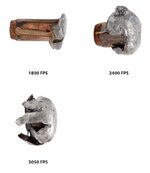My argument is much more simple than even trying to apply logic to a bullet comparison. Bonded bullet performance from the Accubond or normal Partion performance is so well known, and so consistent, there is no reason to look to anything else that “might” work as good or better. It would be trying to solve a performance problem that doesn’t exist. Simply go to the Partion Failure thread and compare that to failure threads of other bullets.
View attachment 884877View attachment 884876
I think it’s great that so many are optimistic that their new favorite bullet is the best thing that has ever slayed a critter. You keep betting on your “new” bullets and I’ll keep betting on the old reliable ones. The biggest misconception is that today’s cup and core fragmenting bullets are anything new. Fragmenting bulllet fandom started with the 22 Savage high power over 100 years ago. It’s nothing new. High BC is new, the bullet performance isn’t. Many of us simply don’t care to hunt with bullets that make a mess out of rather simple situations. Kids we take along on hunts aren’t allowed to use fragmenting bullets because there’s just no reason to throw away an entire quarter, and that happens all the time. We get a laugh out of guys that take the same angled shots we do regularly, and they have buckets of mush to deal with. There are plenty of pics here where guys love it, like a kink. I don’t mean to kink shame anyone.


